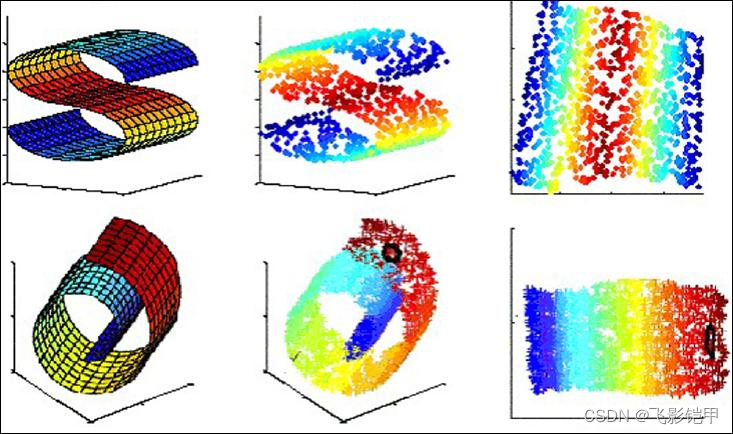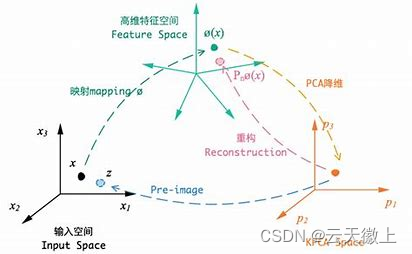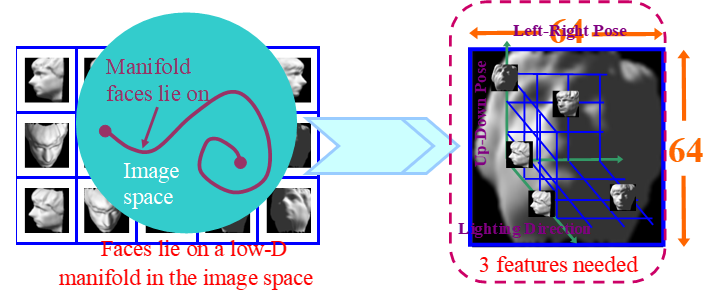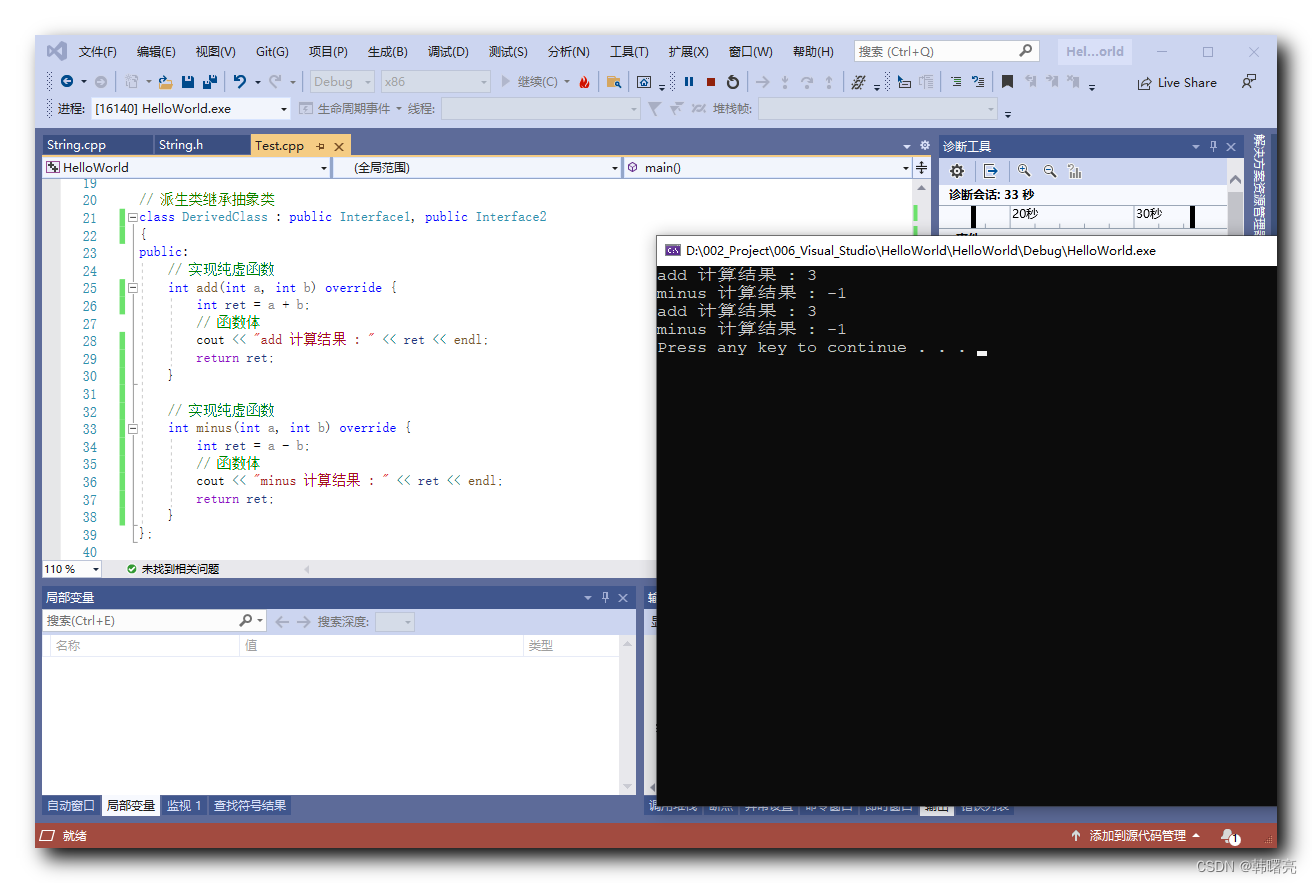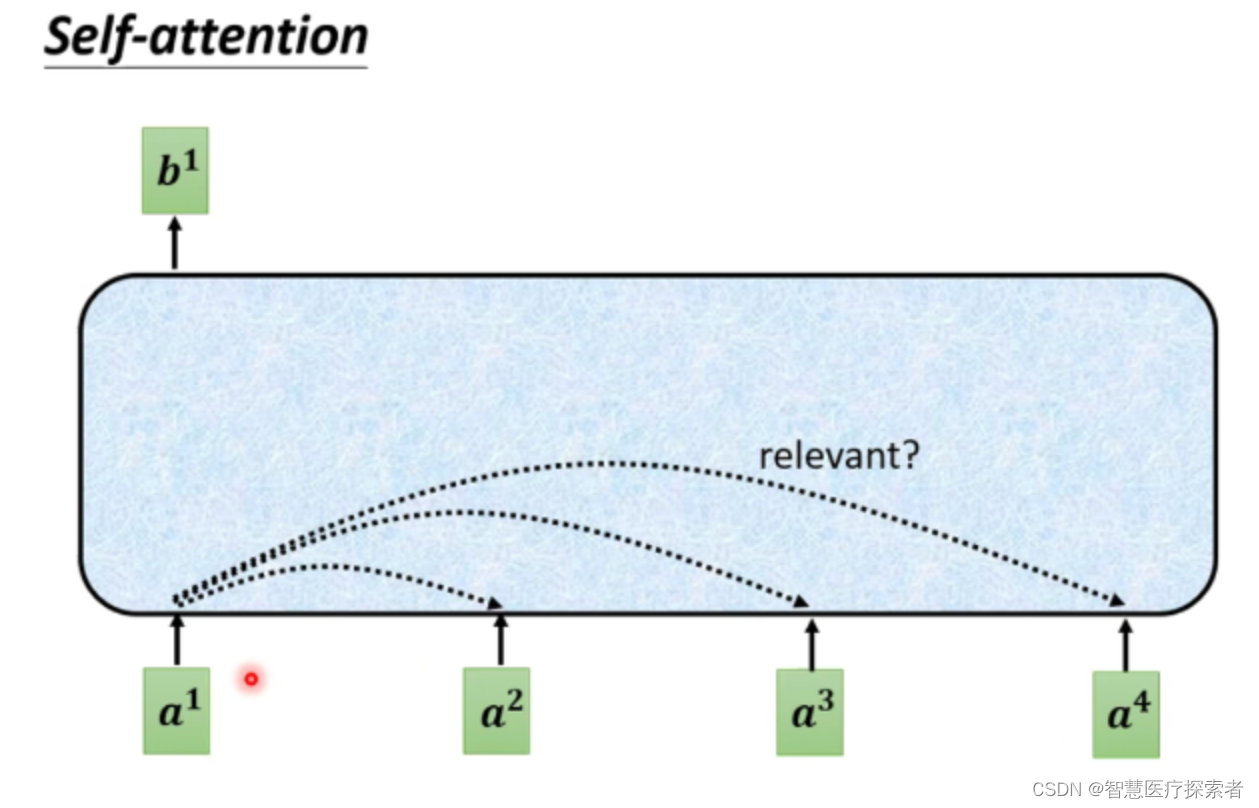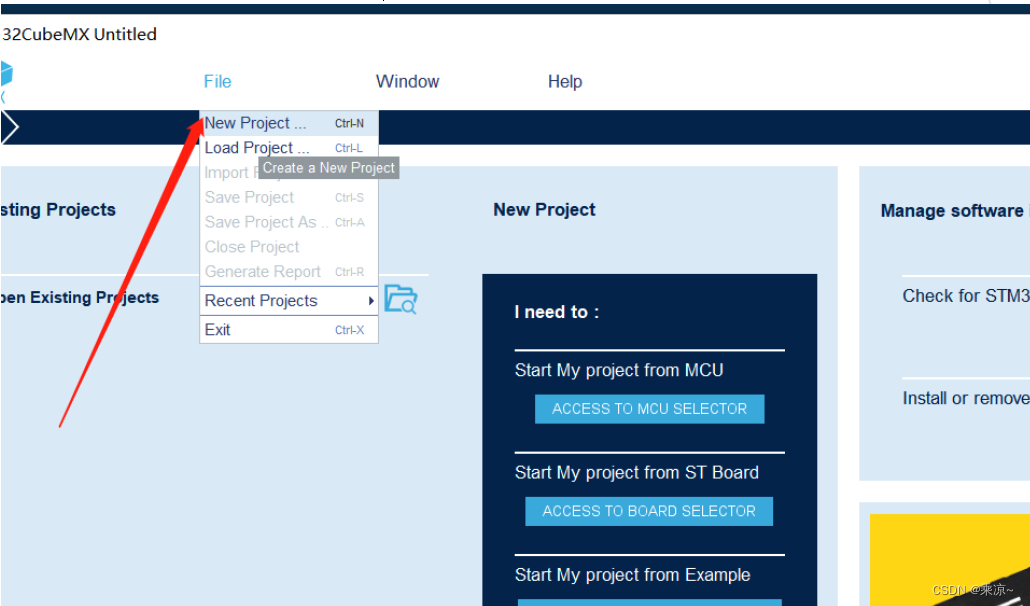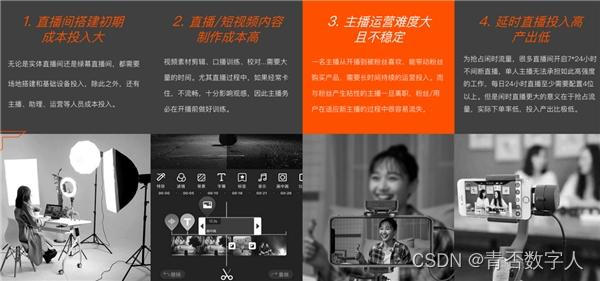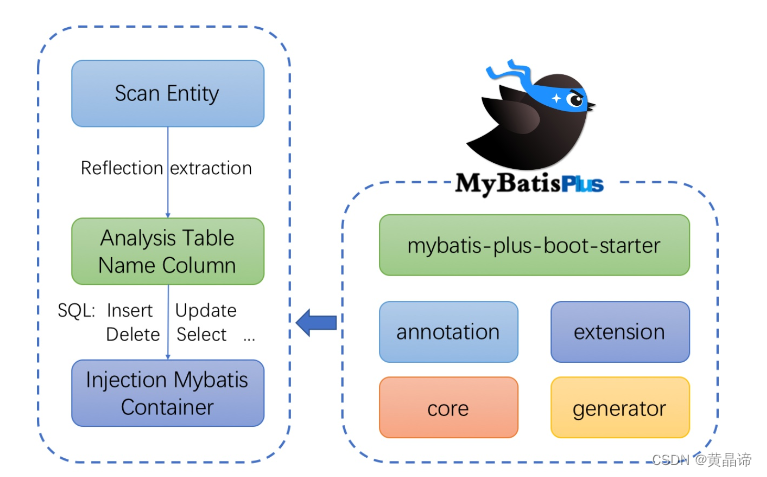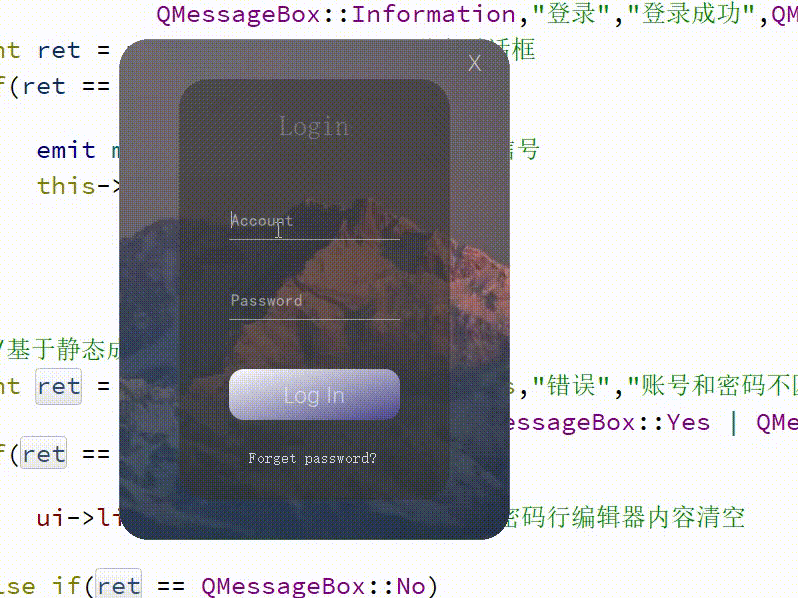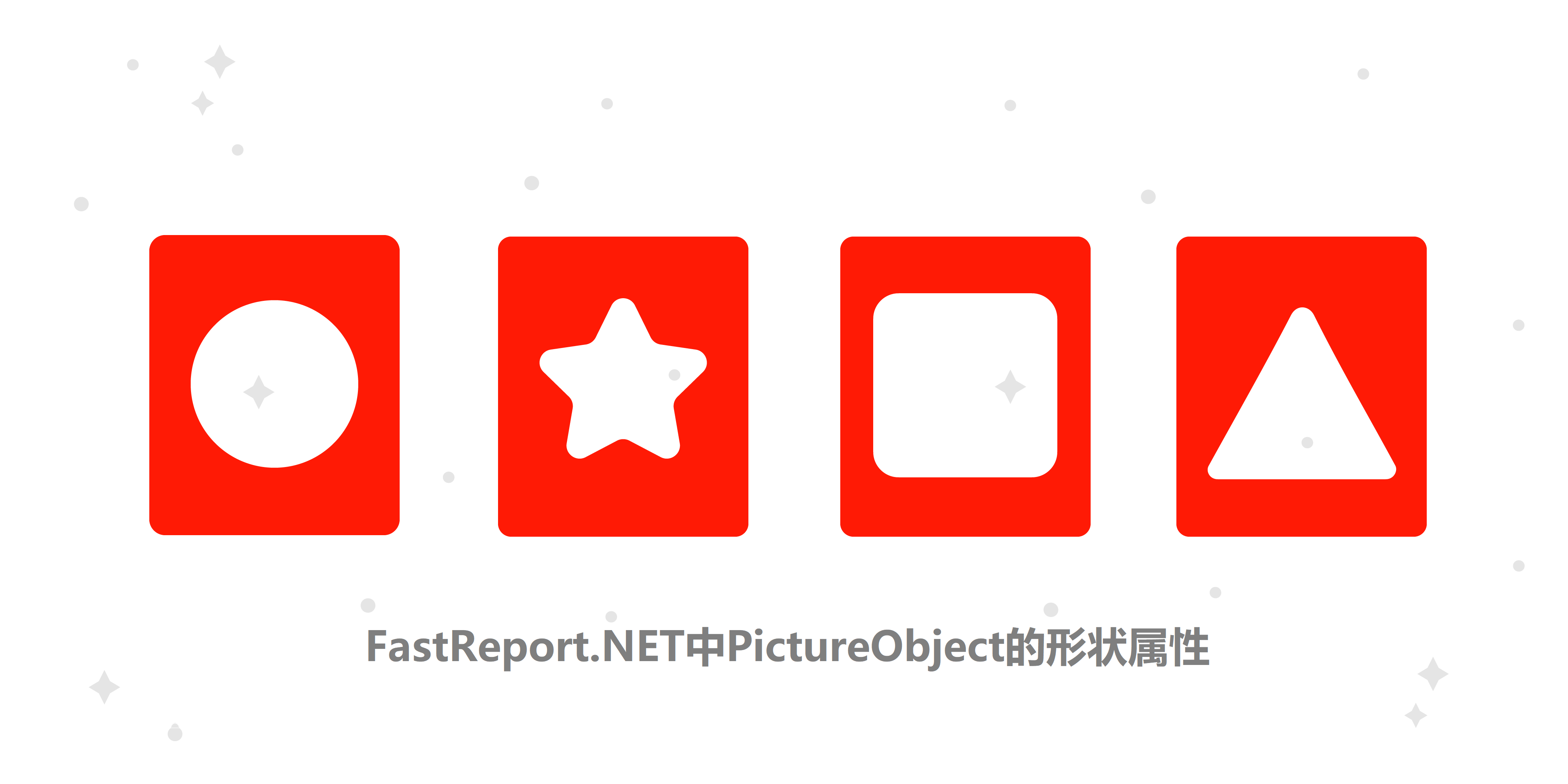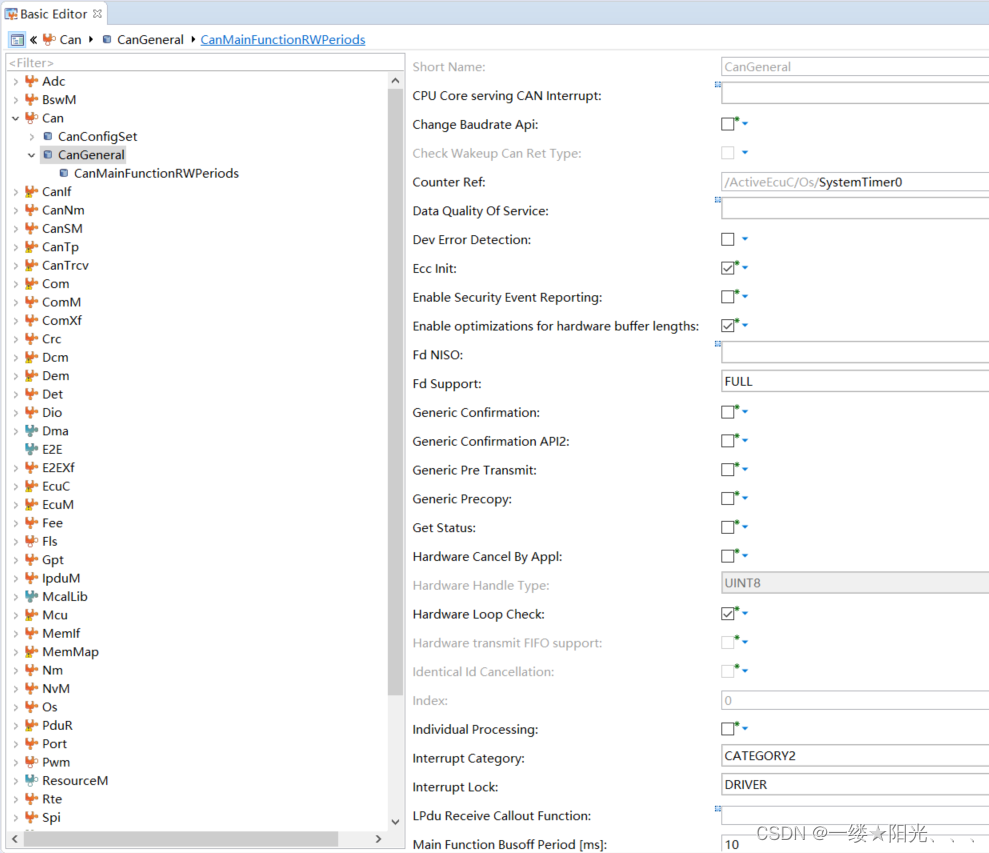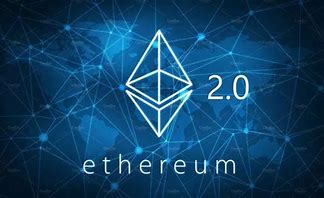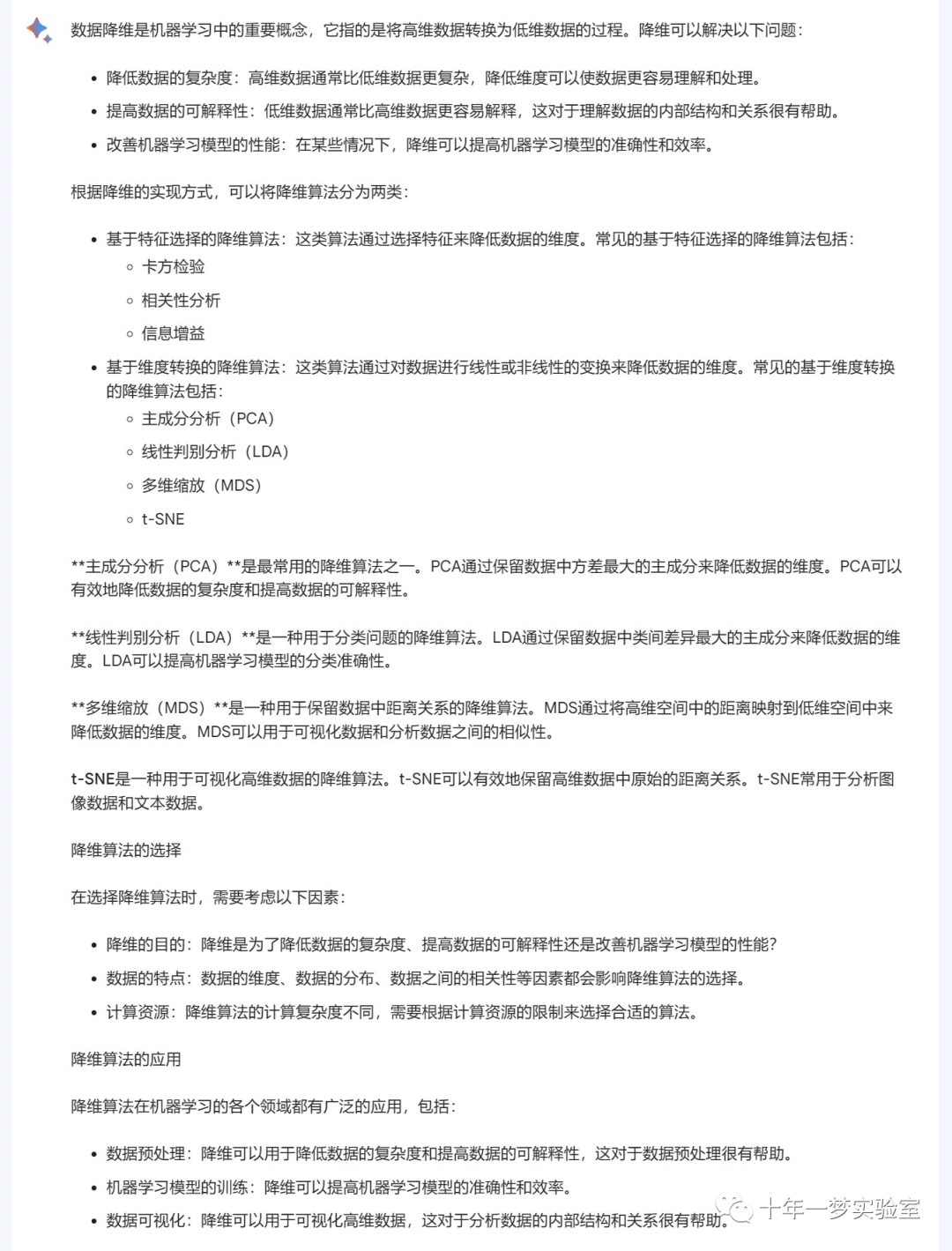

一、理论
1.1 主成分分析

如何计算投影矩阵
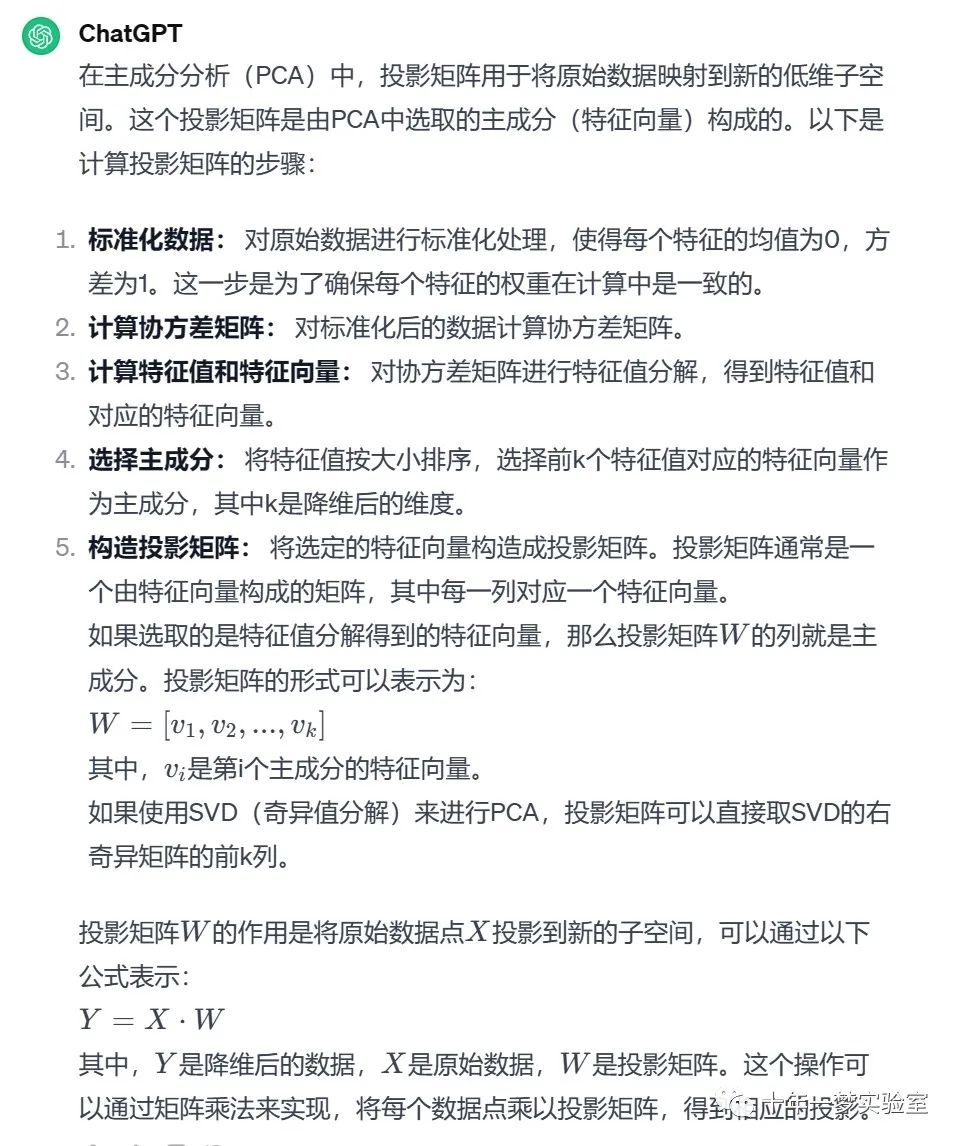
样本向量重构
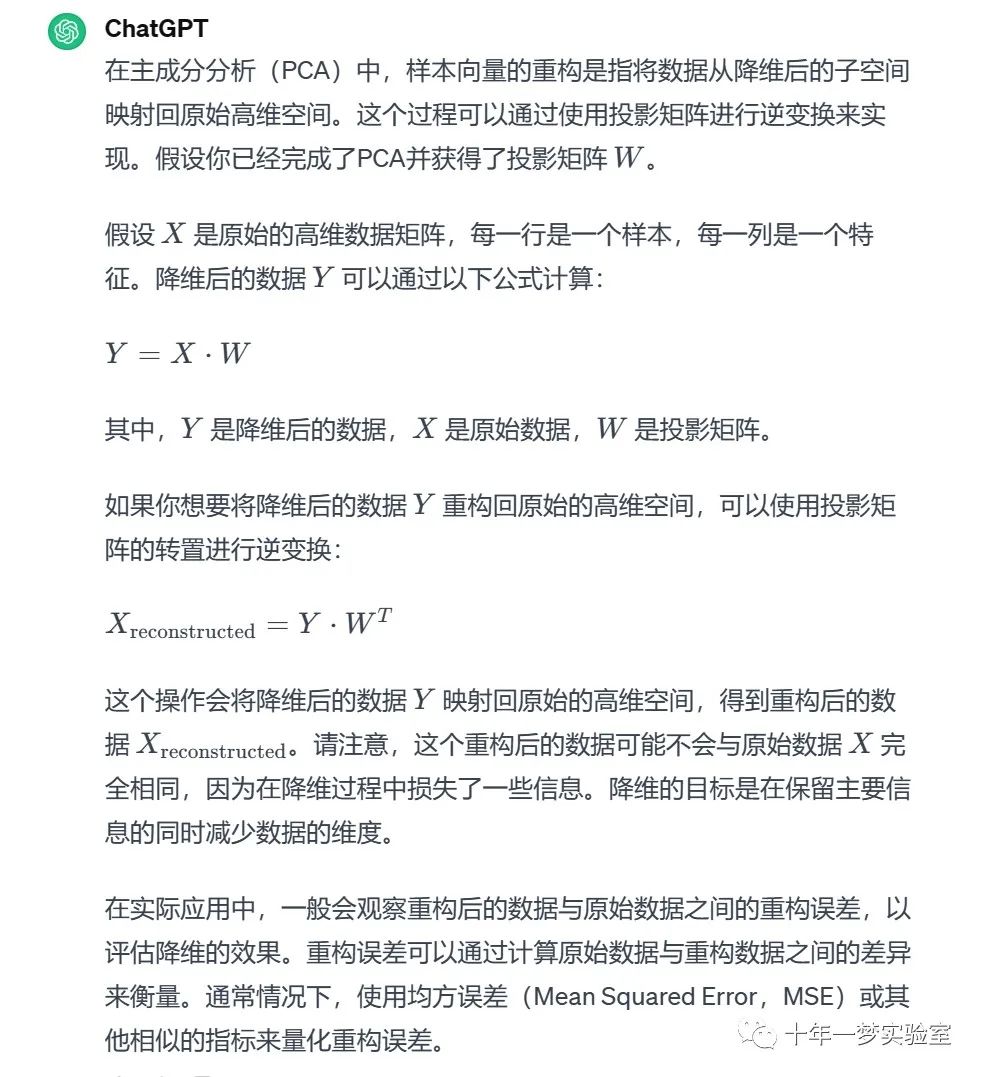
散布矩阵(scatter matrix)

PCA的变体

1.2 流形学习
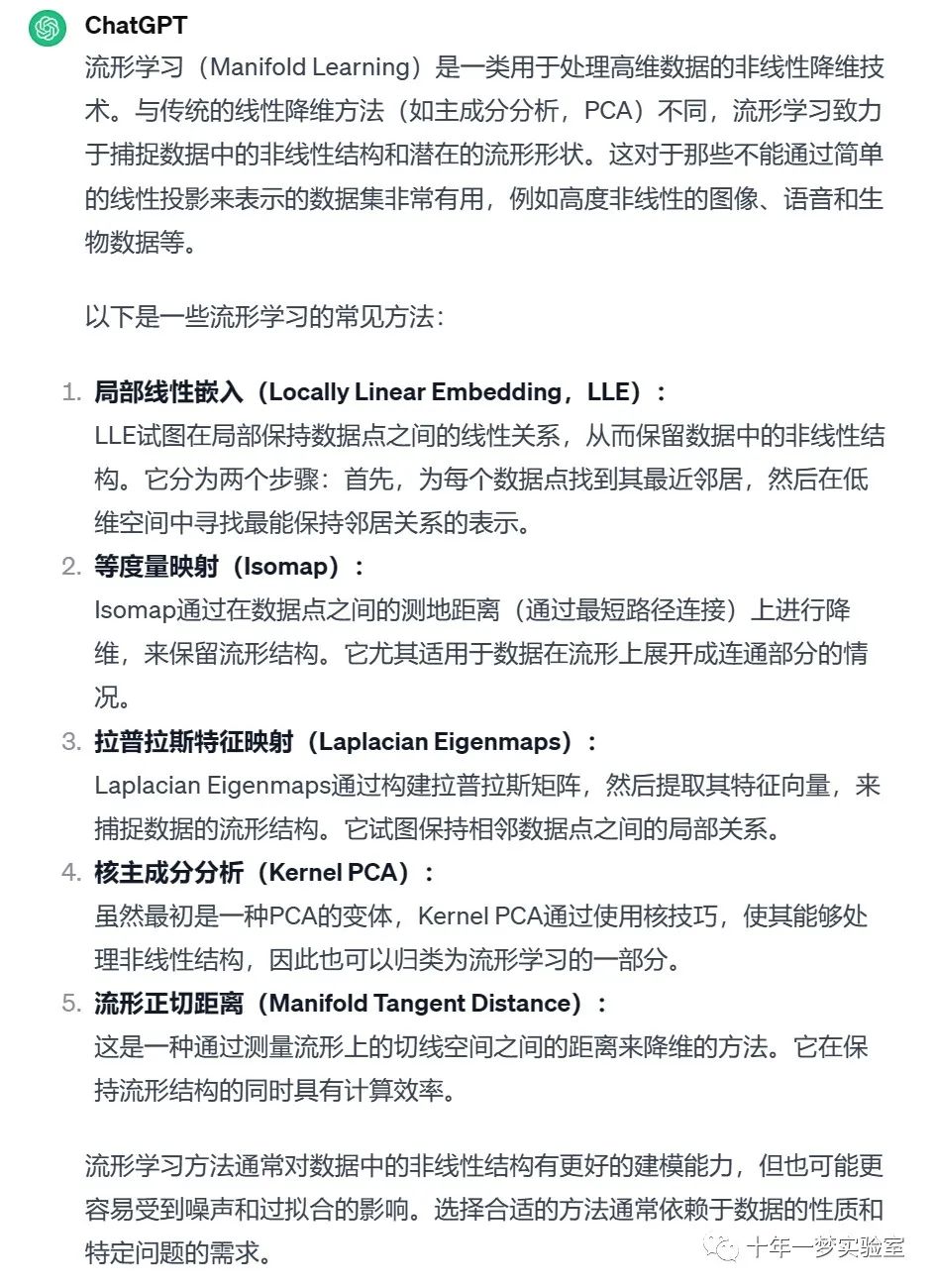

1.2.1 局部线性嵌入

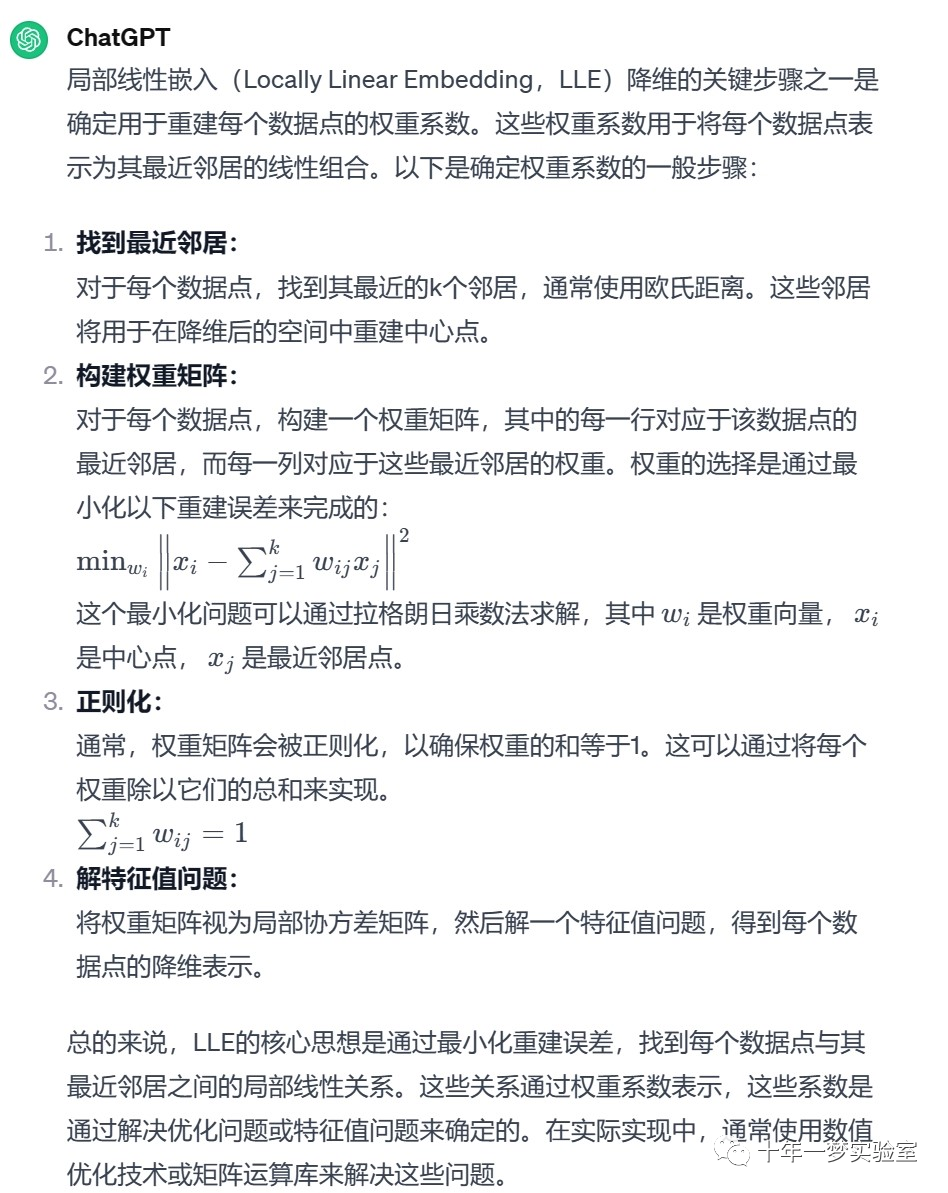
1.2.2 拉普拉斯特征映射

1.2.3 局部保持投影
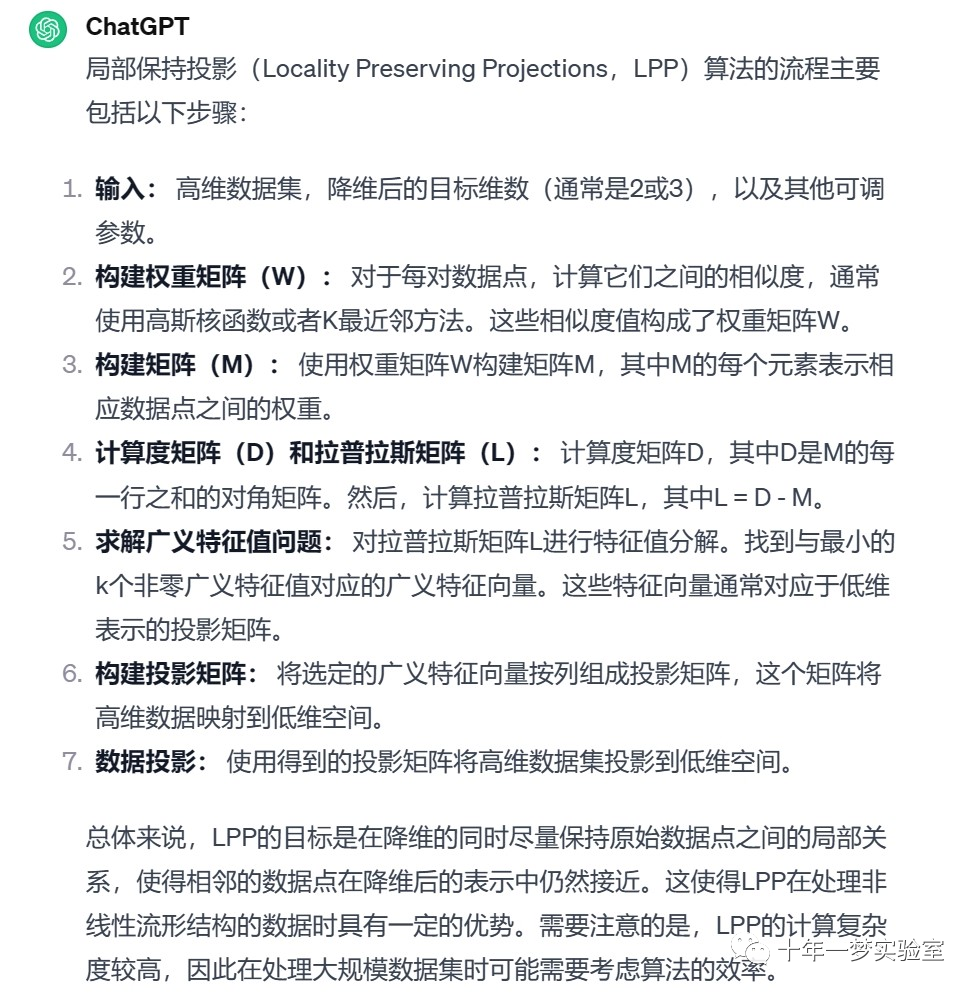
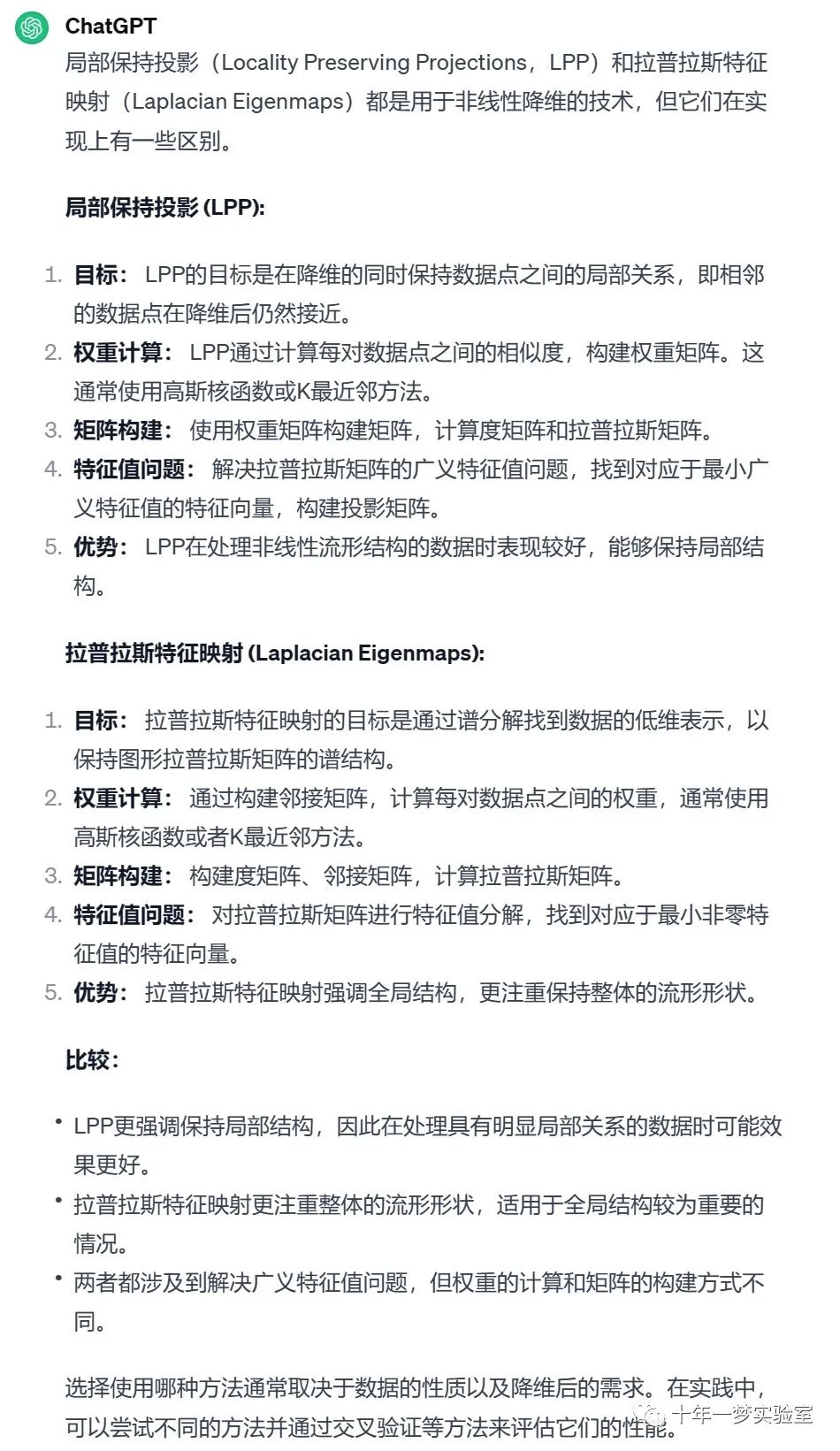
1.2.4 等距映射
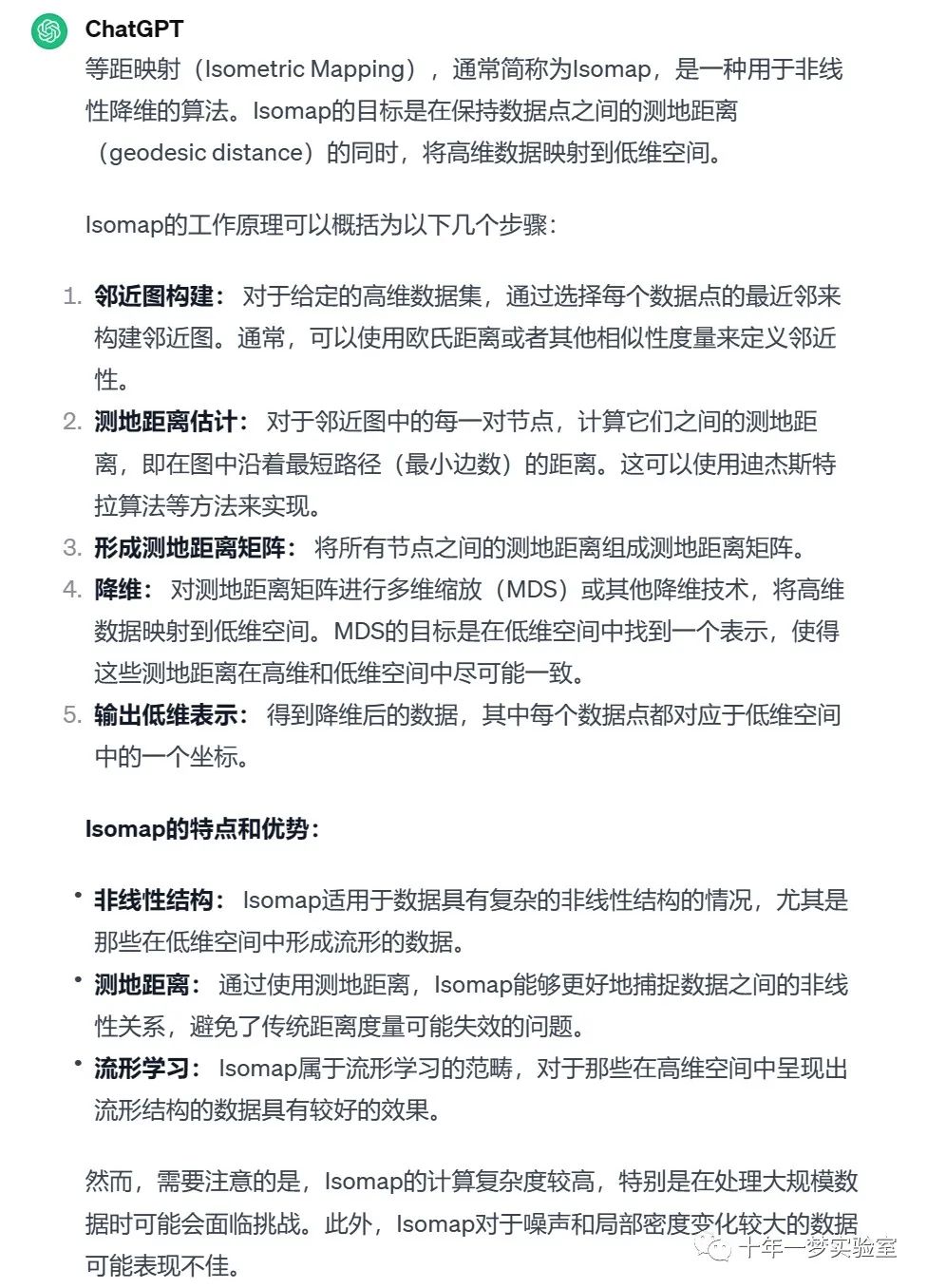
1.2.5 t分布随机近邻嵌入

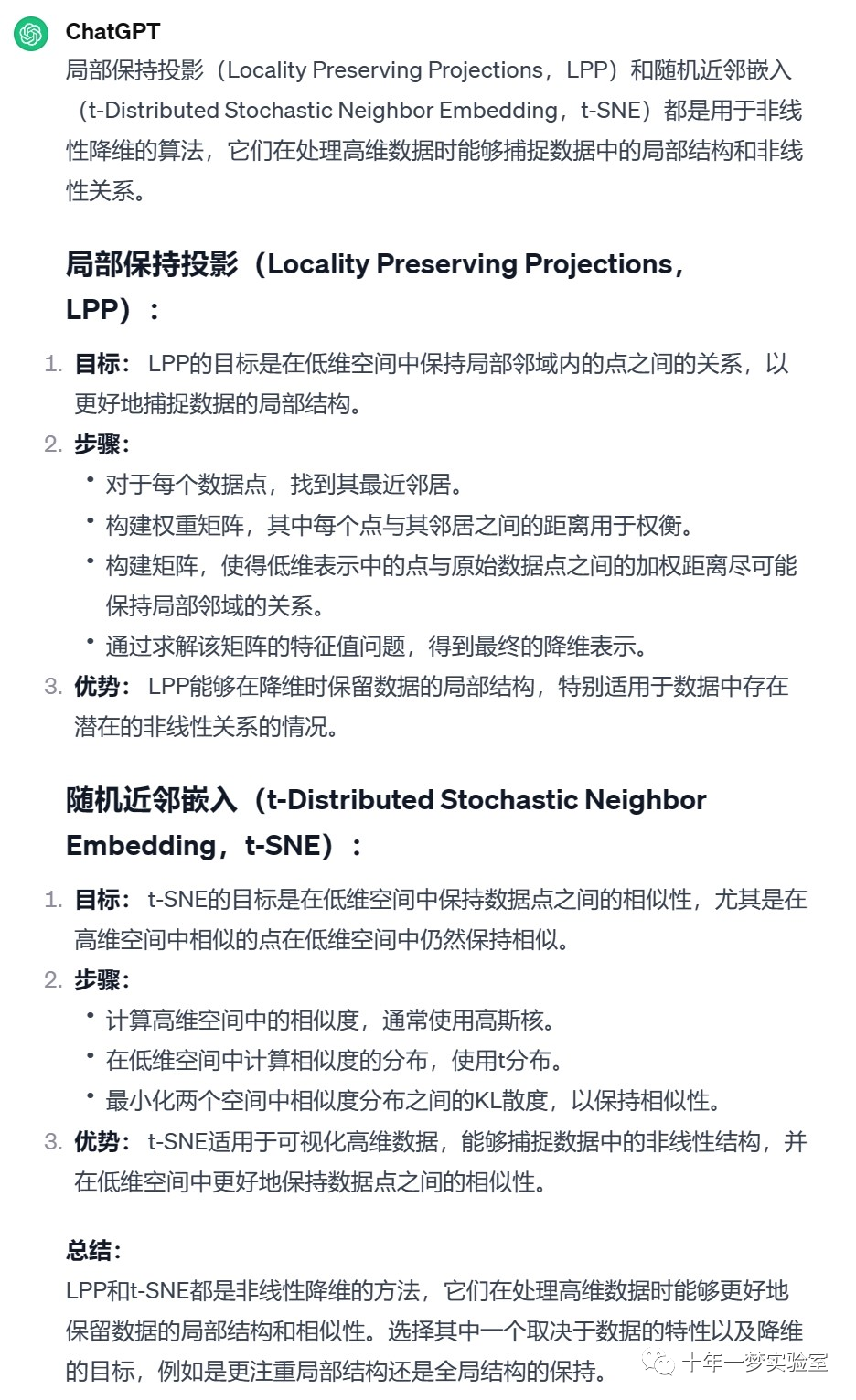
1.2.6 多维缩放

二、示例
2.1 PCA示例 iris数据集

2.2 局部线性嵌入(LLE) 瑞士卷数据降维

2.3 Swiss Roll 和 Swiss-Hole 使用 LLE 和 t-SNE 进行降维比较
# ===================================
# Swiss Roll 和 Swiss-Hole 降维比较
# ===================================
# 这个笔记旨在比较两种流行的非线性降维技术,T-分布随机邻居嵌入(t-SNE)和局部线性嵌入(LLE),在经典的 Swiss Roll 数据集上的效果。接下来,我们将探讨它们在数据中添加孔洞时的处理方式。
# %%
# Swiss Roll
# ---------------------------------------------------
#
# 首先,我们生成 Swiss Roll 数据集。
import matplotlib.pyplot as plt
from sklearn import datasets, manifold
# 生成 Swiss Roll 数据集
sr_points, sr_color = datasets.make_swiss_roll(n_samples=1500, random_state=0)
# %%
# 现在,让我们看看我们的数据:
fig = plt.figure(figsize=(8, 6))
ax = fig.add_subplot(111, projection="3d")
fig.add_axes(ax)
ax.scatter(sr_points[:, 0], sr_points[:, 1], sr_points[:, 2], c=sr_color, s=50, alpha=0.8)
ax.set_title("Swiss Roll in Ambient Space")
ax.view_init(azim=-66, elev=12)
_ = ax.text2D(0.8, 0.05, s="n_samples=1500", transform=ax.transAxes)
# %%
# 计算 LLE 和 t-SNE 的嵌入,发现 LLE 似乎能够很好地展开 Swiss Roll。另一方面,t-SNE 能够保留数据的一般结构,但较差地表示原始数据的连续性。相反,它似乎不必要地将一些点的区域聚集在一起。
# 计算 LLE 嵌入
sr_lle, sr_err = manifold.locally_linear_embedding(sr_points, n_neighbors=12, n_components=2)
# 计算 t-SNE 嵌入
sr_tsne = manifold.TSNE(n_components=2, perplexity=40, random_state=0).fit_transform(sr_points)
# 绘制嵌入结果
fig, axs = plt.subplots(figsize=(8, 8), nrows=2)
axs[0].scatter(sr_lle[:, 0], sr_lle[:, 1], c=sr_color)
axs[0].set_title("LLE Embedding of Swiss Roll")
axs[1].scatter(sr_tsne[:, 0], sr_tsne[:, 1], c=sr_color)
_ = axs[1].set_title("t-SNE Embedding of Swiss Roll")
# %%
# .. 注意::
#
# LLE 似乎将点从 Swiss Roll 中心(紫色)拉伸出来。然而,我们观察到这只是数据生成方式的副产品。在 Swiss Roll 中心附近的点密度较大,最终影响了 LLE 在较低维度中对数据的重构。
# %%
# Swiss-Hole
# ---------------------------------------------------
#
# 现在让我们看看两种算法如何处理我们在数据中添加孔洞。首先,我们生成 Swiss-Hole 数据集并绘制它:
# 生成 Swiss-Hole 数据集
sh_points, sh_color = datasets.make_swiss_roll(n_samples=1500, hole=True, random_state=0)
fig = plt.figure(figsize=(8, 6))
ax = fig.add_subplot(111, projection="3d")
fig.add_axes(ax)
ax.scatter(sh_points[:, 0], sh_points[:, 1], sh_points[:, 2], c=sh_color, s=50, alpha=0.8)
ax.set_title("Swiss-Hole in Ambient Space")
ax.view_init(azim=-66, elev=12)
_ = ax.text2D(0.8, 0.05, s="n_samples=1500", transform=ax.transAxes)
# %%
# 计算 LLE 和 t-SNE 的嵌入,我们得到了与 Swiss Roll 类似的结果。LLE 能够很好地展开数据,甚至保留了孔洞。t-SNE 再次似乎将一些点的区域聚集在一起,但我们注意到它保留了原始数据的一般拓扑结构。
# 计算 LLE 嵌入
sh_lle, sh_err = manifold.locally_linear_embedding(sh_points, n_neighbors=12, n_components=2)
# 计算 t-SNE 嵌入
sh_tsne = manifold.TSNE(n_components=2, perplexity=40, init="random", random_state=0).fit_transform(sh_points)
# 绘制嵌入结果
fig, axs = plt.subplots(figsize=(8, 8), nrows=2)
axs[0].scatter(sh_lle[:, 0], sh_lle[:, 1], c=sh_color)
axs[0].set_title("LLE Embedding of Swiss-Hole")
axs[1].scatter(sh_tsne[:, 0], sh_tsne[:, 1], c=sh_color)
_ = axs[1].set_title("t-SNE Embedding of Swiss-Hole")
# %%
#
# 结论
# ------------------
#
# 我们注意到 t-SNE 受益于测试更多的参数组合。通过更好地调整这些参数,可能会得到更好的结果。
#
# 我们观察到,正如在 "手写数字的流形学习" 示例中所见,t-SNE 通常在真实世界的数据上表现优于 LLE。2.4 在 S-curve 数据集上进行降维的图示,使用了各种流形学习方法
# ========================================
# 流形学习方法的比较
# ========================================
# 这是在 S-curve 数据集上进行降维的图示,使用了各种流形学习方法。
# 有关这些算法的讨论和比较,请参见 :ref:`manifold module page <manifold>`。
# 对于一个类似的示例,其中这些方法应用于球体数据集,请参见 :ref:`sphx_glr_auto_examples_manifold_plot_manifold_sphere.py`
# 请注意,MDS 的目的是找到数据的低维表示(这里是2D),其中距离很好地反映原始高维空间中的距离,与其他流形学习算法不同,它不寻求在低维空间中找到各向同性的数据表示。
# 作者: Jake Vanderplas -- <vanderplas@astro.washington.edu>
# %%
# 数据集准备
# -------------------
#
# 我们从生成 S-curve 数据集开始。
from numpy.random import RandomState
import matplotlib.pyplot as plt
from matplotlib import ticker
import warnings
warnings.filterwarnings('ignore', category=FutureWarning)
# 用于在 matplotlib < 3.2 中进行 3D 投影的未使用但必需的导入
import mpl_toolkits.mplot3d # noqa: F401
from sklearn import manifold, datasets
rng = RandomState(0)
n_samples = 1500
S_points, S_color = datasets.make_s_curve(n_samples, random_state=rng)
plt.rcParams['font.sans-serif'] = ['SimHei'] # 用来正常显示中文标签
plt.rcParams['axes.unicode_minus'] = False # 用来正常显示负号
# %%
# 让我们看一下原始数据。还定义一些辅助函数,我们将在后面使用。
def plot_3d(points, points_color, title):
x, y, z = points.T
fig, ax = plt.subplots(
figsize=(6, 6),
facecolor="white",
tight_layout=True,
subplot_kw={"projection": "3d"},
)
fig.suptitle(title, size=16)
col = ax.scatter(x, y, z, c=points_color, s=50, alpha=0.8)
ax.view_init(azim=-60, elev=9)
ax.xaxis.set_major_locator(ticker.MultipleLocator(1))
ax.yaxis.set_major_locator(ticker.MultipleLocator(1))
ax.zaxis.set_major_locator(ticker.MultipleLocator(1))
fig.colorbar(col, ax=ax, orientation="horizontal", shrink=0.6, aspect=60, pad=0.01)
plt.show()
def plot_2d(points, points_color, title):
fig, ax = plt.subplots(figsize=(3, 3), facecolor="white", constrained_layout=True)
fig.suptitle(title, size=16)
add_2d_scatter(ax, points, points_color)
plt.show()
def add_2d_scatter(ax, points, points_color, title=None):
x, y = points.T
ax.scatter(x, y, c=points_color, s=50, alpha=0.8)
ax.set_title(title)
ax.xaxis.set_major_formatter(ticker.NullFormatter())
ax.yaxis.set_major_formatter(ticker.NullFormatter())
plot_3d(S_points, S_color, "原始 S-curve 样本")
# %%
# 定义流形学习的算法
# -------------------------------------------
#
# 流形学习是一种非线性降维的方法。这个任务的算法基于这样一种思想,即许多数据集的维度只是人为地高。
#
# 在 :ref:`User Guide <manifold>` 中阅读更多。
n_neighbors = 12 # 用于恢复局部线性结构的邻域数量
n_components = 2 # 流形的坐标数
# %%
# 局部线性嵌入
# ^^^^^^^^^^^^^^^^^^^^^^^^^
#
# 局部线性嵌入(LLE)可以被看作是一系列局部主成分分析,这些分析在全局上进行比较以找到最佳的非线性嵌入。
# 在 :ref:`User Guide <locally_linear_embedding>` 中阅读更多。
params = {
"n_neighbors": n_neighbors,
"n_components": n_components,
"eigen_solver": "auto",
"random_state": rng,
}
lle_standard = manifold.LocallyLinearEmbedding(method="standard", **params)
S_standard = lle_standard.fit_transform(S_points)
lle_ltsa = manifold.LocallyLinearEmbedding(method="ltsa", **params)
S_ltsa = lle_ltsa.fit_transform(S_points)
lle_hessian = manifold.LocallyLinearEmbedding(method="hessian", **params)
S_hessian = lle_hessian.fit_transform(S_points)
lle_mod = manifold.LocallyLinearEmbedding(method="modified", modified_tol=0.8, **params)
S_mod = lle_mod.fit_transform(S_points)
# %%
fig, axs = plt.subplots(
nrows=2, ncols=2, figsize=(7, 7), facecolor="white", constrained_layout=True
)
fig.suptitle("局部线性嵌入", size=16)
lle_methods = [
("标准局部线性嵌入", S_standard),
("局部切线空间对齐", S_ltsa),
("Hessian 特征图", S_hessian),
("修改后的局部线性嵌入", S_mod),
]
for ax, method in zip(axs.flat, lle_methods):
name, points = method
add_2d_scatter(ax, points, S_color, name)
plt.show()
# %%
# Isomap 嵌入
# ^^^^^^^^^^^^
#
# 通过等距映射进行的非线性降维。
# Isomap 寻求一个保持所有点之间测地距离的低维嵌入。在 :ref:`User Guide <isomap>` 中阅读更多。
isomap = manifold.Isomap(n_neighbors=n_neighbors, n_components=n_components, p=1)
S_isomap = isomap.fit_transform(S_points)
plot_2d(S_isomap, S_color, "Isomap 嵌入")
# %%
# 多维缩放
# ^^^^^^^^^
#
# 多维缩放(MDS)寻求在低维度空间中表示数据,其中距离很好地反映原始高维空间中的距离。
# 在 :ref:`User Guide <multidimensional_scaling>` 中阅读更多。
md_scaling = manifold.MDS(
n_components=n_components, max_iter=50, n_init=4, random_state=rng
)
S_scaling = md_scaling.fit_transform(S_points)
plot_2d(S_scaling, S_color, "多维缩放")
# %%
# 用于非线性降维的谱嵌入
# ^^^^^^^^^^^^^^^^^^^^^^^^^^^^^^^^^^^^^^^^^^^^^^^^^^^^^^^^^
#
# 该实现使用 Laplacian Eigenmaps,通过图 Laplacian 的谱分解找到数据的低维表示。
# 在 :ref:`User Guide <spectral_embedding>` 中阅读更多。
spectral = manifold.SpectralEmbedding(
n_components=n_components, n_neighbors=n_neighbors
)
S_spectral = spectral.fit_transform(S_points)
plot_2d(S_spectral, S_color, "谱嵌入")
# %%
# t-分布随机邻居嵌入
# ^^^^^^^^^^^^^^^^^^^^^^^^^^^^^^^^^^^^^^^^^^^
#
# 它将数据点之间的相似性转换为联合概率,并试图最小化低维嵌入和高维数据之间的 Kullback-Leibler 散度。
# t-SNE 有一个非凸的成本函数,即使用不同的初始化,我们可以得到不同的结果。在 :ref:`User Guide <t_sne>` 中阅读更多。
t_sne = manifold.TSNE(
n_components=n_components,
learning_rate="auto",
perplexity=30,
n_iter=250,
init="random",
random_state=rng,
)
S_t_sne = t_sne.fit_transform(S_points)
plot_2d(S_t_sne, S_color, "t-分布随机邻居嵌入")三、参考
https://zhuanlan.zhihu.com/p/37777074
https://scikit-learn.org.cn/view/107.html 流形学习
https://scikit-learn.org/stable/
https://www.geeksforgeeks.org/spectral-embedding/?ref=ml_lbp 光谱嵌入
https://scikit-learn.org/stable/auto_examples/manifold/plot_compare_methods.html#sphx-glr-auto-examples-manifold-plot-compare-methods-py 流形学习的方法比较
https://zhuanlan.zhihu.com/p/104655163
https://www.cnblogs.com/tgzhu/p/7389193.html
https://www.geeksforgeeks.org/locally-linear-embedding-in-machine-learning/ 机器学习中的局部线性嵌入
The End

